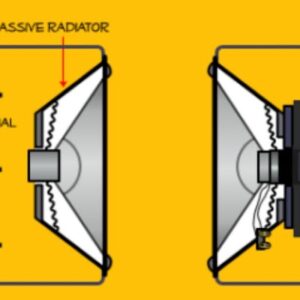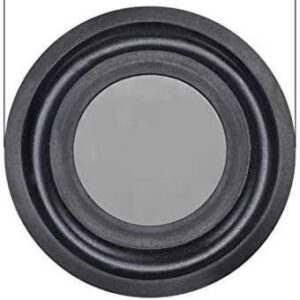 |
| What Are Passive Radiator In Speakers? |
What Are Passive Radiator in Speakers?
 |
| Schematic of how a passive radiator works |
The reason passive speakers are so common is that they are ideal for the diminutive speakers you tend to get with BlueTooth capability. These are speakers that are meant to be easy to move around, carry, and that use low power from USB connections or a battery source.
As we will see, the limitations of mobile speakers make passive systems great design choices for these devices. But passive speakers are not necessarily ideal for traditional, full-sized speakers which enjoy the benefit of being plugged into an AC power outlet.
Passive Radiator Speaker Design
Passive Radiator Speaker Design
A passive radiator is powered by the air pressure generated by the smaller powered speaker inside a modern sound system. They use a subtle and clever method to do a lot of work using very little power.
This principle is easy to test. Simply unscrew one of the active speakers from the speaker housing. Hold the active speaker in place and play your favourite music – preferably something with a lot of bass. Now, while the music is playing, pull the active speaker out of the unit.
The way they work is by sealing the entire speaker unit so that all (or a significant amount of) of the vibration generated by the active speakers is forced to move through the delicate diaphragm inside the passive speaker.
Because the air pressure inside the speaker cannot escape in any direction other than through the passive speakers, the effect of a big, powerful woofer is effectively simulated.
What you’ll experience is the resonant sound generated by the passive speaker stopping. The beautiful, deep tones cease and you’re left with the ugly, tinny whining of the unaided passive speakers. To double-check your findings, simply replace the active speaker and you’ll hear those gorgeous, golden tones return.
We don’t recommend doing this test on any speaker that you don’t mind ruining, because there’s a chance that the seal will be permanently compromised.
The seal should be easy to fix with a little bit of super glue, but again – don’t do this test if you’re not willing to take the risk.
What Are The Benefits of Passive Radiator?
A passive radiator makes it possible for woofers to generate deep, resonant tones that could normally only come from speakers with AC power contained in a large housing or box. Passive radiators use the principle that makes the diaphragms in your eardrums do what they do – respond to very low levels of energy for a great effort.
Depending on the tuning when passive radiators are built into a system, it will begin moving just as the drive woofer starts to create low frequencies.
By engaging precisely at this point, passive radiators absorb energy from the active speaker. This reduces the motion of the drive woofer. The effect is called dampening. Because the drive woofer moves less, the risk of damage is also reduced.
In other words, passive speakers will not “blow out” as easily, like active speakers are prone to do. The power that drives passive speakers is much more gentle, in essence – making the speaker diaphragm much more likely to stay well within its mechanical tolerance. It really is an elegant solution to a long-standing problem.
This dampening effect is also conducive to the creation of smaller speakers that use less power and that are designed to be highly portable. The reduced range of motion of the woofer diaphragm, the absence of additional wires and power components, and the seal dependent design of the unit all contribute to the ability of these speakers to remain small and deliver satisfying level of the power.
Another important advantage of passive speakers is they are relatively inexpensive to produce. While the technology is still relatively new, you can expect to pay a premium for the novelty for a few more years to come. However, as these items lose the aura of newness, you can expect to be able to afford a heck of a lot of audio power at an increasingly lower price.






